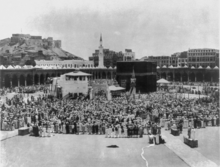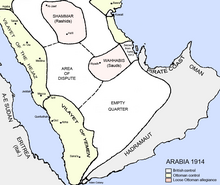Hejaz vilayet
| Vilayet of the Hejaz ولاية الحجاز (Arabic) ولايت حجاز (Ottoman Turkish) | |||||||||
|---|---|---|---|---|---|---|---|---|---|
| Vilayet of the Ottoman Empire | |||||||||
| 1872–1916 | |||||||||
|
Hejazi | |||||||||
| Area | |||||||||
• 1914[3] | 250,000 km2 (97,000 sq mi) | ||||||||
| Population | |||||||||
• 1914[1] | 300,000 | ||||||||
| History | |||||||||
| 1872 | |||||||||
| 1908 | |||||||||
| 1916 | |||||||||
| |||||||||
| Today part of | Saudi Arabia Jordan | ||||||||
The Vilayet of the Hejaz (
Despite its lack of natural resources, the region had great political importance as the cradle of Islam and was a source of legitimacy for the Ottomans' rule.[4] Subsidies provided by the state and zakat were the main source of income for the population of the two holy cities, but trade generated by the hajj was also an important source of revenue.[4]
The Ottoman regular force in Hejaz was constituted as a fırka (division), attached to the Seventh Army in Yemen.[5] Outside of cities and towns, Ottoman authority was weak.[6] Only Medina and Jeddah had permanent garrisons.[4]
History
Background

Sultan
Saudi conquest
Since the 1750s,
The Ottoman government found itself unable to confront the Wahhabis, and gave the task of defeating them to the powerful
Vilayet period

In the late 1860s, a commission was sent to the Hejaz to reorganize the province, and the following decades saw the introduction of administrative reforms.

The towns of Mecca and Medina were exempted from paying taxes and in fact, were given subsidies, called surre, from the Ottoman treasury that was to be distributed to the poor in Mecca and Medina.
The Ottomans maintained a garrison force of 7,000 soldiers under the command of officers, in addition to the Sharif's own personal guard of 500.
The Ottomans completed the
Demographics
The exact population of the Hejaz is impossible to determine, particularly because of the mobility of Bedouins and pilgrims, and also because of the inability of Ottoman authorities to conduct a census in Arabia.
Most of the population was not settled, and included nomads and
Economy
The economy of the vilayet relied heavily on the annual
Hejaz's primary exports were
The mercantile centre of the region was the port city of
Due to the region's intense heat and scarcity of rainfall, the Hejaz could not support an agriculture-based economy. Agriculture was only possible in oases and on the irrigated outskirts of major towns, with dates being the primary crop grown. Semi-nomadic tribes would also engage in agriculture or would herd sheep and camels.[23]
Administrative divisions

Sanjaks of the Vilayet:[26]
- Sanjak of Mekke-i-Mükerreme(Mecca)
- Sanjak of Medine-i-Münevvere (Medina); became an independent sanjak in the summer of 1910.[27]
- Sanjak of Cidde(Jeddah)
See also
Notes
- ^ ISBN 978-0-615-24479-2.
- ^ a b c Numan 2005, p. 61-62.
- ^ A. H. Keane, page 459
- ^ ISBN 978-1-4381-1025-7.
- ^ Numan 2005, p. 68.
- ^ Numan 2005, p. 22.
- ^ a b Numan 2005, p. 33.
- ^ Numan 2005, p. 35.
- ISBN 978-0-313-32110-8.
- ^ Numan 2005, p. 37.
- ^ a b Numan 2005, p. 38.
- ^ ISBN 978-0-391-00304-0.
- ^ a b Numan 2005, p. 39.
- ^ Numan 2005, p. 42.
- ^ a b c d Numan 2005, p. 71.
- ^ Numan 2005, p. 43.
- ^ a b c d Hogarth 1978, pp. 47.
- ^ Numan 2005, p. 18.
- ^ Nabataea: Hijaz Railway: History
- ISBN 9780814203668.
- ISBN 9780814203668.
- ^ a b c Numan 2005, p. 20.
- ^ a b c Numan 2005, p. 16.
- ^ Numan 2005, p. 17.
- ^ a b Numan 2005, p. 19.
- ^ Ceziretül Arab – Hicaz ve Yemen Vilayetleri | Tarih ve Medeniyet
- ISBN 978-0-203-00909-3.
References
- Numan, Nurtaç (November 2005), The Emirs of Mecca and the Ottoman Government of Hijaz, 1840-1908, The Institute for Graduate Studies in Social Sciences
- Hogarth, David George (1978). Hejaz before World War I : a handbook (2nd ed. [reprinted] ed.). Cambridge: Oleander Press [etc.] ISBN 9780902675742.
External links
- Wahab, Robert Alexander (1911). . In Chisholm, Hugh (ed.). Encyclopædia Britannica. Vol. 13 (11th ed.). Cambridge University Press. p. 217.
- William L. Ochsenwald, "Religion, society, and the state in Arabia: the Hijaz under Ottoman control, 1840-1908", The Ohio State University Press 1984
 Media related to Vilayet of Hejaz at Wikimedia Commons
Media related to Vilayet of Hejaz at Wikimedia Commons



